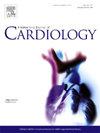双重抗血小板治疗冠状动脉旁路移植术后出血风险的准确预测:机器学习模型与precision - dapt评分
IF 3.2
2区 医学
Q2 CARDIAC & CARDIOVASCULAR SYSTEMS
引用次数: 0
摘要
背景:冠状动脉旁路移植术(CABG)后双重抗血小板治疗(DAPT)虽然可能对缺血事件有保护作用,但可导致不同程度的出血,导致严重的临床事件,包括死亡。本研究旨在开发准确且可扩展的预测工具,用于早期识别CABG后DAPT期间的出血风险,并将其与precisdapt评分进行比较。方法:收集2021年6月至2023年12月在南京鼓楼医院接受孤立CABG的患者的临床数据。数据集以7:3的比例分成衍生组和验证组。开发了机器学习模型来预测DAPT患者cabg后6个月内的出血,并在临时外部验证队列中进行了测试。SHapley加性解释方法可视化了结果的变量重要性。precision - dapt评分的表现也在该队列中得到验证。结果:561例入组患者中,165例(29.4 %)发生出血事件,49例(8.7 %)有显著性出血。在验证队列中,极端梯度增强(eXtreme gradient boosting, XGB)在受试者工作特征曲线(0.915)和精确查全率曲线(0.692)下的面积最大。与precision - dapt相比,XGB的AUROC无差异(p = 0.808),但AUPRC较高(p = 0.009)。在时间外部验证队列中,XGB模型的AUROC为0.926,AUPRC为0.703。我们开发了一个基于XGB模型的动态高精度出血风险计算器,并创建了一个移动友好的QR码,以便于访问该工具。结论:使用选定的基线特征可以可靠地预测cabg后患者DAPT期间的出血风险。XGB模型优于precision - dapt模型,显示出更好的精度和召回率。本文章由计算机程序翻译,如有差异,请以英文原文为准。
Accurate prediction of bleeding risk after coronary artery bypass grafting with dual antiplatelet therapy: A machine learning model vs. the PRECISE-DAPT score
Background
Dual antiplatelet therapy (DAPT) after coronary artery bypass grafting (CABG), although might be protective for ischemic events, can lead to varying degrees of bleeding, resulting in serious clinical events, including death. This study aims to develop accurate and scalable predictive tools for early identification of bleeding risks during the DAPT period post-CABG, comparing them with the PRECISE-DAPT score.
Methods
Clinical data were collected from patients who underwent isolated CABG at Nanjing Drum Tower Hospital between June 2021 and December 2023. The dataset was split into derivation and validation cohorts at a 7:3 ratio. Machine learning models were developed to predict bleeding within six months post-CABG in DAPT patients and tested in a temporal external validation cohort. The SHapley Additive exPlanations method visualized variable importance regarding outcomes. The performance of the PRECISE-DAPT score was also validated in this cohort.
Results
Among 561 enrolled patients, 165 (29.4 %) experienced bleeding events, with 49 (8.7 %) cases being significant. In the validation cohort, eXtreme gradient boosting (XGB) achieved the highest area under the receiver operating characteristic curve (0.915) and precision-recall curve (0.692). Compared to PRECISE-DAPT, XGB showed no difference in AUROC (p = 0.808) but had a higher AUPRC (p = 0.009). In the temporal external validation cohort, the XGB model has an AUROC of 0.926 and an AUPRC of 0.703. We developed a dynamic high-accuracy bleeding risk calculator based on the XGB model and created a mobile-friendly QR code for easy access to this tool.
Conclusion
Bleeding risk during DAPT in post-CABG patients can be reliably predicted using selected baseline features. The XGB model outperforms the Precise-Dapt model, showing better precision and recall.
求助全文
通过发布文献求助,成功后即可免费获取论文全文。
去求助
来源期刊

International journal of cardiology
医学-心血管系统
CiteScore
6.80
自引率
5.70%
发文量
758
审稿时长
44 days
期刊介绍:
The International Journal of Cardiology is devoted to cardiology in the broadest sense. Both basic research and clinical papers can be submitted. The journal serves the interest of both practicing clinicians and researchers.
In addition to original papers, we are launching a range of new manuscript types, including Consensus and Position Papers, Systematic Reviews, Meta-analyses, and Short communications. Case reports are no longer acceptable. Controversial techniques, issues on health policy and social medicine are discussed and serve as useful tools for encouraging debate.
 求助内容:
求助内容: 应助结果提醒方式:
应助结果提醒方式:


